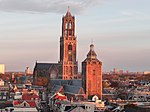Duitse Huis

The Duitse Huis (English: Teutonic House) is a complex of buildings in the city of Utrecht, Netherlands, protected as a national monument. The older parts date to a monastery of the Bailiwick of Utrecht of the Teutonic Knights founded in 1348. Originally Catholic, the order became Protestant during the Reformation. A military hospital was added in 1823 after the knights had sold the property. The property was sold back to the Bailiwick of Utrecht and a major renovation started in 1992. Some of the older buildings are again the headquarters of the Bailiwick of Utrecht, now a charity, and hold an important collection of medieval manuscripts, coins and pictures. Other buildings, including the former hospital, have been converted into a five-star hotel, the Grand Hotel Karel V.
Excerpt from the Wikipedia article Duitse Huis (License: CC BY-SA 3.0, Authors, Images).Duitse Huis
Geertebolwerk, Utrecht
Geographical coordinates (GPS) Address Nearby Places Show on map
Geographical coordinates (GPS)
| Latitude | Longitude |
|---|---|
| N 52.087972 ° | E 5.118495 ° |
Address
Grand Hotel Karel V
Geertebolwerk 1
3511 XA Utrecht (Utrecht)
Utrecht, Netherlands
Open on Google Maps







